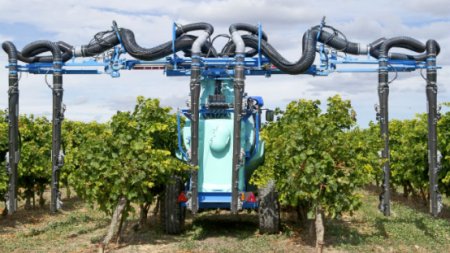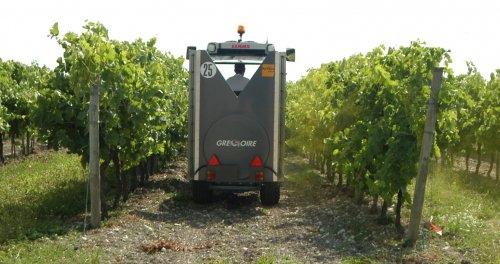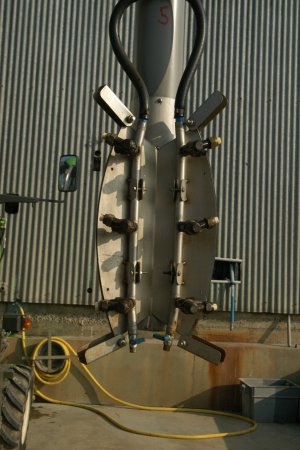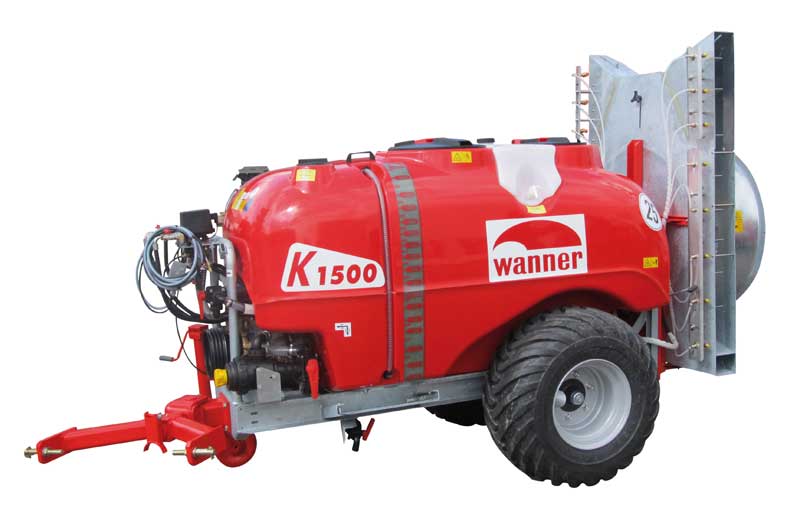Airblast sprayer
An air-blast sprayer uses a stream of air to spray the spray liquid in fine droplets onto the vegetation. A fan, often helical, generates a strong current of air (20,000 to 80,000 m³/hour at speeds of 50 to 200 km/h) which transports the droplets and ensures good coverage and penetration of the foliage. The spray booms are positioned at the outlet of the air blown by the fan. The technology includes different types of fan (axial flow, tangential flow) and can use centrifugal nozzles to produce homogenous droplets. Fan assistance improves agitation and penetration of the product into the vegetation.

Technical presentation
A tractor-mounted sprayer uses the lift of an air stream to spray the spray liquid in fine drops onto the vegetation.
The droplet is transported by a large air current created by a fan, traditionally helical (on most machines). The volumes of air moved vary from 20,000 to 80,000 m3/hour and air speeds from 50 to 200 km/h.
These machines are designed to treat large volumes of foliage. The large volume of air generated ensures thorough mixing of the foliage and good penetration of the product inside, as well as good coverage of the vegetation.
The droplet is transported by a large air current created by a fan, traditionally helical (on most machines). The volumes of air moved vary from 20,000 to 80,000 m3/hour and air speeds from 50 to 200 km/h.
These machines are designed to treat large volumes of foliage. The large volume of air generated ensures thorough mixing of the foliage and good penetration of the product inside, as well as good coverage of the vegetation.

Face-to-face airblast sprayer
The liquid circuit of an airblast sprayer is comparable in every way to that of a jet sprayer. However, the booms are located where the air blown by the fan exits to charge it with droplets.
Why air-blast?
Because the droplets produced by pressurising the liquid or centrifuging it are picked up as they leave the nozzle by a large volume of air, which carries them towards the target and penetrates the vegetation. A fan can also be used to agitate the vegetation, helping to improve penetration.

Descent - Belly

PreciJet - Tecnoma
The different types of mounted sprayer
Airblast sprayer with axial-flow fan

Airblast sprayer with axial flow fan
These are called axial flow fans because the air passes through the turbine parallel to the turbine's axis of rotation.
These devices are often mistakenly referred to as aeroconvection devices. This term refers to a particular type of air-blast device consisting of a high turbine combined with deflectors that direct the air towards the ground, which acts as a reflector, so that the air loaded with droplets is treated from the bottom upwards, hence the term convection associated with aeroconvection.
Airblast sprayer with tangential flow fan

Airblast sprayer with tangential flow fan
These sprayers use fans consisting of a cylinder with a large number of small fins on its periphery (with the profile of an aircraft wing).
The special feature of this system is that it generates a very homogenous volume of air over the entire height of the vegetation to be treated, into which the droplets produced by the nozzles are integrated.
Airblast sprayers with centrifugal nozzles
Characterised by the production of highly homogenous droplets, this type of spraying uses centrifugal force to break up the stream of liquid into droplets. The droplet is formed by the rotation of a small-diameter disc, or bowl, with a crenellated periphery. On some machines, the element that forms the droplet can have other shapes, such as a screened cylinder (often used for aerial spraying).Nozzles are usually driven by a hydraulic motor, which also drives the fan to transport the drops. Sometimes, electrical energy (or more rarely pneumatic energy) can replace hydraulic energy.
In centrifugal spraying, the finer the drop, the better:
- The flow rate of the equipment is low
- The speed of rotation of the nozzle is high
- The diameter of the element that forms the drop is large.
The CH (Coefficient of Homogeneity) is generally between 1.2 and 1.6.
Airblast sprayers based on pneumatic equipment
These sprayers are very similar in configuration to pneumatic sprayers, using a centrifugal fan. The difference lies in the diffuser, where the droplets are produced by a turbulence or slot nozzle.Although they are very similar to pneumatic sprayers, they are air-jet sprayers, since the droplets are formed by pressurising the liquid and transporting it by air. It should be noted that the conversion of some pneumatic equipment to air-assisted spraying is not without its problems (lack of pump pressure, high and unnecessary pressure losses in the nozzles).
Experiment
See the list of experimentsSee more - Adjusting your airblast sprayer - 2020
- [EQUIPMENT TEST] Adjustment sheet: Berthoud AIR DRIVE airblast sprayer - 2020
- [EQUIPMENT TEST] Adjustment sheet: AMOS TB / EVO3 mounted sprayer / 6000 jet cell - 2020
- [EQUIPMENT TEST] Adjustment sheet: AMOS TB / EVO3 M mounted sprayer / faupin cell - 2020
- [EQUIPMENT TEST] Adjustment sheet: AMOS TB / EVO4 mounted sprayer / independent turbines - 2020
- [EQUIPMENT TEST] Adjustment sheet: Tecnoma PreciJet mounted sprayer - 2020
- [EQUIPMENT TEST] Adjustment sheet: Wanner airblast sprayer - 2019
- [EQUIPMENT TEST] Adjustment sheet: Optimus 55P Hardi boom - 2019
- [EQUIPMENT TEST] Adjustment sheet: Guyard sprayer with 5-row recuperator panels - 2017
- [EQUIPMENT TEST] Adjustment sheet: Dynadiff diffusers on FlexiSpray downpipes Gregoire - 2015
- [EQUIPMENT TEST] Set-up sheet: AB MOST Berthoud boom - 2015
- [EQUIPMENT TEST] Adjustment sheet: Faupin TB mounted sprayer - 2015
